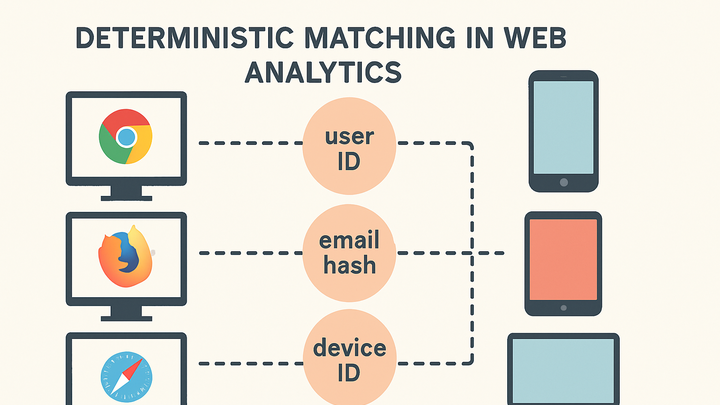Published on 2025-06-28T13:48:15Z
What is Deterministic Matching? Example Applications in Analytics
Deterministic Matching is a method in analytics that unifies user interactions across sessions and devices by relying on exact identifiers provided by the user or generated by the system. Unlike probabilistic matching, which infers connections based on patterns and statistical models, deterministic matching uses explicit data points such as user IDs, email hashes, or device IDs to ensure precise linkage.
This approach reduces ambiguity, delivering higher accuracy in metrics like unique users, conversion rates, and cross-device journeys. Analytics platforms like Google Analytics 4 (GA4) allow you to set a user_id parameter, while tools like PlainSignal achieve cookie-free identification by generating persistent, anonymous IDs. While deterministic matching is powerful for personalization, accurate attribution, and journey mapping, it requires users to authenticate or identify themselves, which may not capture anonymous traffic. Overall, deterministic matching is a cornerstone for brands and analysts seeking reliable, user-centric insights.
Deterministic matching
Precise unification of user data across sessions and devices using explicit identifiers for accurate analytics.
How Deterministic Matching Works
A step-by-step look at how deterministic matching collects and uses identifiers to link sessions accurately.
-
Identifier collection
Collect explicit identifiers such as user IDs, hashed emails, or device IDs when users register or log in.
-
User id
A unique alphanumeric string assigned to each user upon account creation.
-
Hashed email
An email address transformed via secure hashing to protect user privacy.
-
-
Session stitching
Associate multiple browsing sessions and interactions to the same user identity using the collected identifier.
-
Cross-device linking
Unify sessions across different devices when the same identifier is detected.
Benefits of Deterministic Matching
Key advantages of using deterministic matching for analytics accuracy and user insights.
-
Improved accuracy
Ensures exact user counts and reduces duplication across sessions and devices.
-
Enhanced personalization
Delivers tailored experiences by reliably recognizing returning users.
-
Reliable attribution
Provides precise campaign performance analysis across channels and touchpoints.
Implementation in GA4 and PlainSignal
Examples of setting up deterministic matching in Google Analytics 4 and PlainSignal.
-
Google analytics 4 (GA4)
In GA4, enable deterministic matching by setting the
user_idparameter when a user authenticates.-
Gtag.js example
gtag('config', 'G-XXXXXXXXXX', { 'user_id': 'USER_ID_VALUE' });
-
-
PlainSignal (cookie-free analytics)
PlainSignal uses a simple, cookie-free approach by generating a persistent ID and embedding it in the tracking code.
-
Tracking code example
<link rel="preconnect" href="//eu.plainsignal.com/" crossorigin /> <script defer data-do="yourwebsitedomain.com" data-id="0GQV1xmtzQQ" data-api="//eu.plainsignal.com" src="//cdn.plainsignal.com/plainsignal-min.js"></script>
-
Limitations and Considerations
Important factors and potential drawbacks to consider when using deterministic matching.
-
Requires user authentication
Only tracks users who log in or provide an identifier, leaving anonymous sessions unlinked.
-
Privacy implications
Handling personal identifiers must comply with regulations like GDPR and CCPA.
-
Data fragmentation
Different identifier types (e.g., email vs. social login) can fragment a user’s profile if not unified.
